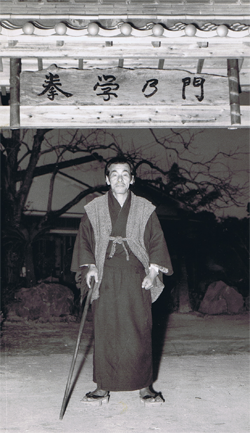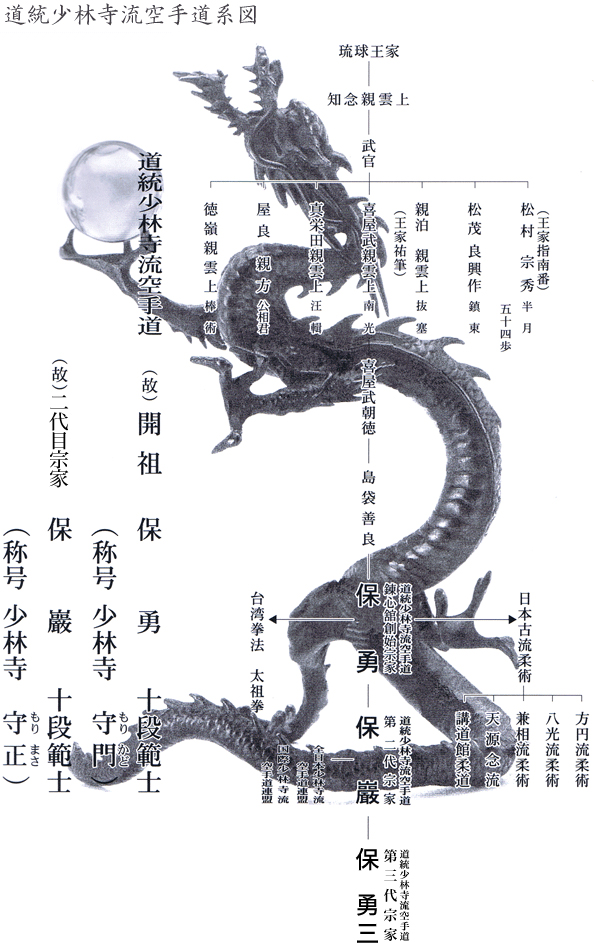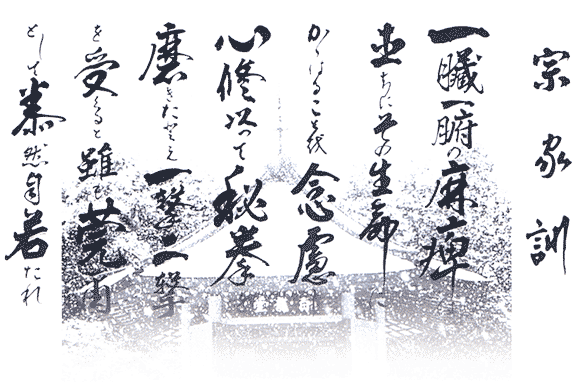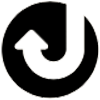少林寺空手道錬心舘の起こり
少林寺流空手道錬心舘は、開祖(故)保勇(たもついさむ)宗家により誕生しました。
開祖は少年時代隣家に住む沖縄糸満の漁師より空手術の手ほどきを受け、17歳のとき台湾に渡ります。台中市武徳殿において(故)中原忠男先生のもとで講道舘柔道を学び、また中国拳法の達人(故)陳老師より中国南派拳法を修得します。
第二次世界大戦後、人心の荒廃を憂い、武道による人づくりを発願。沖縄に渡り、沖縄空手界で名人キャンと謳われた(故)喜屋武朝徳先生の直流を(故)島袋善良先生より修得し、正流七法の型を集大成しました。
空手道の他にも開祖の武暦は広く、講道館柔道・方円流体術・兼相流柔術・八光流柔術、他、棒・杖、釵(サイ)・剣を修得。これら半生にわたって体得した諸武術を総合整理し、さらに鬼気迫る猛稽古の末に自ら編み出した幾多の組手技を付加して、1955年11月8日、鹿児島市高麗町に少林寺流空手道研究会・錬心舘道場を開設。僅か10坪にも満たない小さな道場から錬心舘空手道の輝ける歴史が始まりました。
The Foundation of Shorinjiryu
Karate-do Renshinkan
The late Soke Tamotsu Isamu founded the Shorinjiryu Karate-do Renshinkan. In his childhood, he was taught the basics of Karate by the fisherman who lived in his neighborhood in Itoman-city, Okinawa Prefecture. When he was 17 years old, he went to Butokuden in Taichung-city, Taiwan, where he learned Kodokan-jujutsu from the late master Tadao Nakahara and southern Chinese martial arts from the late master Roshi Chin who was an expert of Chinese martial arts.
After the World War II, grieving for desolation for people’s mind, he decided to cultivate their spirits through Bu-do. He came back to Okinawa and learned the legitimate legacy of Okinawa Karate from the late Zenryo Shimabukuro who was the disciple of the late Chutoku Kyan who was famous as Master Kyan in the Okinawa Karate community, and completed the basic Kata(forms) of “Seiryu-shichiho” or “Authentic seven Methods.”
Isamu mastered not only Karate-do but also Kodokan jujutsu, Hoen-ryu taijutsu, Kenso-ryu jujutsu, Hakko-ryu jujutsu, Bo-jutsu (martial arts using a stick), Jo-jutsu (martial arts using a short cane staff), Sai-jutsu (martial arts using a dagger-shaped truncheon) and so on. Thus, he comprehensively organized the various martial arts that he mastered over half a lifetime and also added in many Kumite techniques devised by himself through extremely intense training.
On November 8th, 1955, he started the Shorinji-ryu Karate-do Association and the Renshinkan dojo in Koma-chou, Kagoshima. The glorious history of Renshinkan began in the small dojo measuring less than 350 square feet.

- 拳学乃門の前にて写真(モノクロ)
- *Photograph in front of Kengaku-no-mon

開祖保 勇少林寺守門
- 少林寺流空手道連盟錬心舘 創始宗家
十段範士 称号 少林寺守門 - 勲四等瑞宝 受章
開祖(故)保勇宗家は、1919年(大正8年)鹿児島県奄美市に生まれました。戦後当時、型至上主義の中にかたくなまでに固執していた空手道の封建制を打破。未開拓であった組手技術の一大集成をなしとげます。 人命尊重の見地から一貫して組手における安全性と合理性を追求。安全かつ実拭的な防具着用の試合制度を実施し、勝敗の明確化につとめ、スポーツ性と武道性を兼ね備えた真の大衆武道としての組織を確立。空手界に新機軸を打ち立てました。

- 開祖保 勇 宗家の写真
- *Photograph of the founder Tamotsu Isamu
又、空手道は東洋道義の根幹を形成する五徳(信義礼智仁)の涵養に最も資する武道であるというゆるがぬ信念の下、早くから空手道を通した人づくりに心血を注ぎました。
錬心舘創設時、既に若き門弟と共に「真の空手道の創造と健全な社会の創造」をめざし、日本全土に人間形成の空手道を広める「大志」を持ちます。その道程は耐乏困窮の中に困難を極めましたが、ウィリアム・ワーズワースの「暮らし低くとも 想いは高く」の言葉を愛し、艱難辛苦の日々を温め、錬心舘を日本空手界に冠たる一大拳団に発展させました。その卓越した技量と人格により「空手界の至宝」と謳われています。
全日本少林寺流空手道連盟、鹿児島県空手道連盟、西日本空手道連盟を結成し会長に就任。
1964年 鹿児島県日置市伊集院町に拳士ヶ丘(総本山)を開山し拳士の塔を建立。
1965年 中国体育総会の招きを受け、武道家として戦後始めて中国大陸を訪問します。日中武術界の交流に努め、この方面でも先覚者としての道を歩み続けました。
Isamu Tamotsu
- The Founder of Shorinji-ryu Karate-do Federation Renshinkan
- 10th Dan Master
- The title of Shorinji Morikado
- Awarded The Order of the Sacred Treasure, 4th Class (Gold Rays with Rosette)
The late Soke Tamotsu Isamu, the founder of Renshinkan, was born in Amami City, Kagoshima Prefecture in 1919. He broke away the feudal system of Karate-do, which had stubbornly adhered to the Kata supremacy at the time after the war, and achieved to form the foundation of undeveloped Kumite(sparring) techniques.
From the perspective of the respect for human life, he consistently pursued safety and rationality of Kumite, and implemented the match rule requiring players to wear protective gears. He also clarified the judgement of the win or lose, and laid the foundation of Renshinkan as a genuine popular martial art that combined the spirit of sport and Bu-do. Those efforts brought a new concept to Karate world.
Furthermore, with the firm belief that Karate-do is the Bu-do that best contributes to cultivating the Gotoku or Five-virtues (Sincerity, Righteousness, Propriety, Wisdom, and Benevolence) that form the basis of Eastern morality, he devoted himself to educating people through Karate-do from an early stage. Founding of Renshinkan, he and his young disciples were already aiming for the creation of Karate-do for the people’s mind and the sound society, and had high aspiration to spread Karate-do for humanity development throughout Japan. Although the journey was extremely difficult due to the post-war severe poverty, he kept hope alive, had the words of William Wordsworth, “Plain living and high thinking,” in his mind, and overcame much hardships. Eventually he developed Renshinkan into one of the largest organizations in the Karate world of Japan, and his outstanding skills and the personality made him “the great treasure in Karate world”.
He founded the All Japan Shorinji-ryu Karate-do Federation, the Kagoshima Karate-do Federation and the West Japan Karate-do Federation, and assumed the chairman of these federations.
In 1964: Founded Kenshi-ga-oka (headquarters of Renshinkan) in Ijuin-cho, Hioki City, Kagoshima Prefecture, and built a monument called Kenshi-no-to.
In 1965: At the invitation of the Chinese National Sports Council, he became the first martial artist to visit the mainland after the war. He strived to strengthen the relationships between Japanese and Chinese martial arts worlds, and continued on his path as a pioneer in this field as well.

A precept of Soke Tamotsu Isamu:
Thinking that the paralysis of one organ or one bowel is immediately life-threatening,
hone the skills with compulsory training,
and even if you receive a blow or two, keep calm with a smile.
二代目保 巖
十段範士 称号
故第二代目宗家保巖十段範士は開祖保勇十段範士の長男として昭和23年鹿児島県名瀬市にて誕生。平成12年5月少林寺流空手道錬心舘宗家を襲名。
師であり、父である開祖の薫陶の下、厳しい修行を重ね、型・組手の技術を極めます。
全国大会における特別演武少林寺流正流七法の最高峰「公相君(クーシャンクー)」の型は、壮絶豪快の中に華麗さを備えた完成された型と評され、また、組手技術は防ぐことのできない空手道の最終技術として空手界の畏怖の的となった「後ろ回し蹴り」「連続回し蹴り」「二段廻転蹴り」「足刀くの字飛び」「螺旋回し蹴り」「逆風足刀蹴り」等あらゆる技術に精通して、昭和42年、第一回全国選手権大会において圧倒的な強さで優勝を飾り、以来指導者として普及活動を開始。
昭和44年若干19歳でフィリピンに渡り、バギオ商工科大学で指導。昭和46年には台湾派遣団の団長として台北市に於いて指導、昭和56年にはドミニカ共和国を拠点に中米各国で指導、現在活動する米国、台湾、ドミニカ共和国、プエルトリコ、パナマなど海外支部の基礎を創りました。近年は欧州、インド、イラン、北米など各地で指導にあたり、深い精神性を有する代表的な日本武道として、年々、愛好者の数を増やし空手道の国際化に貢献され、また、国際交流や福祉活動も積極的に展開された。
「空手道の神髄は型にあり。」合理性に立脚した華麗でスピード感溢れる型の指導普及を通じて心技体に充実した健全な青少年の育成に大きく貢献しました。とりわけ、少年拳士達の可能性を引き出し、少年空手道を全国的に広めたことは顕著な功績でした。
平成28年11月29日享年69歳、惜しまれつつ逝去されました。挙聖と謳われた開祖保勇師の後継者として、少林寺流空手道の国際化と正流七法の型の正確な伝承に貢献された尊い生涯でありました。

- Photograph of Soke the second
- A precept of Soke Tamotsu Iwao:
- Those who only sweat for three months do not know the sweat in three years.
- Three years' worth of sweat is far from thirty years.
Tamotsu Iwao the second
- 10th Dan Master
- The title of Shorinji Morimasa
The late Tamotsu Iwao the second Soke was born in Naze City, Kagoshima Prefecture in 1945 as the first son of the late Tamotsu Isamu who was the founder and 10th Dan Master.
In May 2000, he inherited the Soke of Shorinji-ryu Karate-do Renshinkan. Through rigorous training under the tutelage of his mentor and also father, the founder, he mastered the highest level of Kata and Kumite techniques.
The Kata of Kushanku, the highest grade of the Shorinjiryu “Seiryu-shichiho” , which was performed by him at the national convention, was described as a completed Kata with splendor in the midst of grandeur. Furthermore, Kumite techniques he performed became the object of awe and fear in the Karate world as the highest techniques that cannot be blocked such as "back round kick", "continuous round kick", "two-stage round kick", "side-kick Kunoji jump ", "spiral spinning kick" and "jumping side kick".
In 1967: he won the first national championship with overwhelming strength, and since then, he started promoting activities of Renshinkan Karate as an instructor.
- In 1969: at the age of 19, he went to the Philippines and taught at Bagio University of Commerce and Technology.
- In 1971: he served as the leader of Taiwan delegation in Taipei City.
- In 1981: he began teaching in Central American countries based in the Dominican Republic and laid the foundation of the branches in the United States, the Dominican Republic, Puerto Rico, and Panama that are currently active.
In recent years, he taught Karate in Europe, India, Iran, and all-over North America, increased the number of enthusiasts year by year, and contributed to the globalization of Karate. He also actively promoted international exchanges and welfare activities.
"Kata is the essence of Karate-do," he greatly contributed to cultivating healthy youth with fulfillment of mind, technique and body (Shin-Gi-Tai) through the spread of brilliant Kata with a full sense of speed based on rationality. In particular, it is a remarkable achievement that he brought out the potential of juvenile Kenshi or practitioners and spread Karate for boys and girls nationwide.
On November 29th, 2016, he sadly passed away at the age of 69.
As the successor of the founder Tamotsu Isamu, who was hailed as truly a master of Karate or “Kensei”,
he had a worthful life that contributed to the internationalization of the Shorinji-ryu Karate-do and observing the exact tradition of Kata “Seiryu-shichiho” or Authentic Seven Methods.

